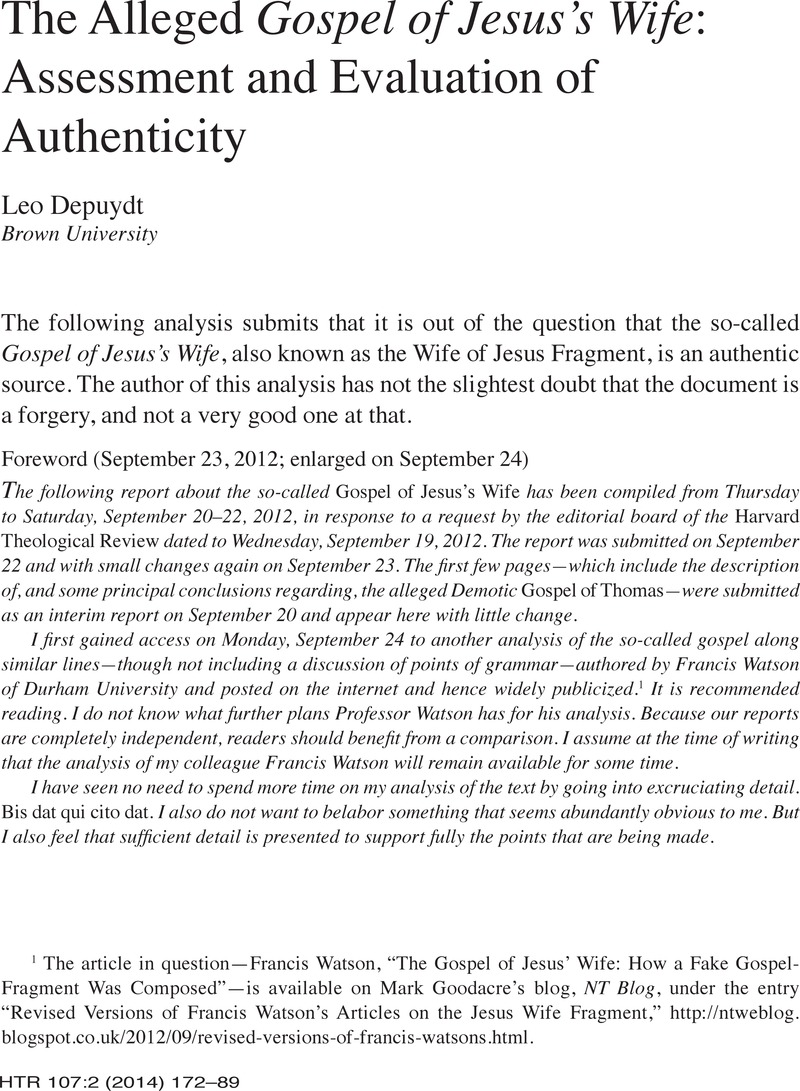Published online by Cambridge University Press: 10 April 2014

1 The article in question—Francis Watson, “The Gospel of Jesus’ Wife: How a Fake Gospel-Fragment Was Composed”—is available on Mark Goodacre's blog, NT Blog, under the entry “Revised Versions of Francis Watson's Articles on the Jesus Wife Fragment,” http://ntweblog.blogspot.co.uk/2012/09/revised-versions-of-francis-watsons.html.
2 de Laplace, Le Marquis (Pierre Simon), Théorie analytique des probabilités (3rd ed.; Œuvres complètes de Laplace 7; Paris: Gauthier-Villars, 1886) cliiiGoogle Scholar.
3 See the references in my “The Mathematical and Physical Theory of Rational Human Intelligence: Complete Empirical-Digital Properties; Full Electrochemical-Mechanical Model (Part I: Mathematical Foundations),” Advances in Pure Mathematics 3 (2013) 491–561, http://dx.doi.org/10.4236/apm.2013.35071.
4 Andrew Bernhard, “How The Gospel of Jesus's Wife Might Have Been Forged: A Tentative Proposal,” available on the following website: http://www.gospels.net/gjw.
5 Farrior, Mary-Evelyn, “Divorcing Mrs. Jesus: Reactions to the Gospel of Jesus’ Wife,” The College Hill Independent 25 (October 5, 2012) 5–6Google Scholar, students.brown.edu/College_Hill_Independent/?p=7296.
6 Mark Goodacre, pers. comm., October 2, 2012; see also idem, “Whatever Happened to the Gospel of Jesus’ Wife?,” NT Blog, December 5, 2013, http://ntweblog.blogspot.com/2013/12/whatever-happened-to-gospel-of-jesus.html.
7 Alin Suciu, “A Peculiar Dialectical Feature in the Gospel of Jesus's Wife, Line 6,” Patristics, Apocrypha, Coptic Literature and Manuscripts [blog], September 27, 2012, http://alinsuciu.com/2012/09/27/alin-suciu-hugo-lundhaug-an-interesting-dialectal-feature-in-the-gospel-of-jesuss-wife-line-6/.
8 Copies of this article, whether in scanned form or hard copy, can be made available upon request.
9 Depuydt, Leo, “Analyzing the Use of Idioms Past (with Special Focus on Sovereign Nubia),” Studien zur altägyptischen Kultur 27 (1999) 33–63Google Scholar, at 54–55 n. 62.
10 Laplace, Théorie analytique des probabilités, v–cliii; the relevant passage is found at xii–xiii. The introduction appeared separately as Essai philosophique sur les probabilités. An English translation of the sixth edition is A Philosophical Essay on Probabilities (trans. Frederick Wilson Truscott and Frederick Lincoln Emory; New York: Dover, 1951), where the relevant passage is found at 12–14.
11 The aforementioned analogy with the case of throwing dice has only limited validity. The case of the dice has mainly been adduced to evidence the debilitating effect of the rules of compound probability on the probability that a compound event will occur. Even so, there are ways of creating artificial models that make the case of phrases found in a text identical in probability structure to the case of throwing dice. Let us assume that there is a total of exactly 10,000 extant phrases in Sahidic Coptic. Then let there be exactly 100 different phrases in the language and let each different phrase occur exactly 100 times, including six phrases occurring once in the Gospel of Thomas, for a total of 10,000 phrases. If the 10,000 phrases are inscribed on balls and placed in a big urn, the chance of drawing a ball inscribed with a certain phrase randomly is exactly 1/100 or 1%. As in the case of the dice, each different outcome now has an equal chance of taking place. A ratio of 1% is quite large and the chance of drawing the phrase in question hence relatively high. A large ratio is favorable to the assumption that the phrases in the Wife of Jesus Fragment have no connection with the Gospel of Thomas. It is at the same time clear that any ratios found in actual reality are bound to be smaller if not much smaller. The chance of encountering a certain specific phrase would hence be much, if not very much, lower than 1% in the artificial model. And so would the probability that there is no connection between the Fragment and the Gospel of Thomas. The chance of drawing balls inscribed with six specific phrases from said urn is exactly 100/10000 × 100/10000 × 100/10000 × 100/10000 × 100/10000 × 100/10000, or 1/100 × 1/100 × 1/100 × 1/100 × 1/100 × 1/100, or also 1 in a trillion (1,000,000,000,000), practically zero. The assumption is that the balls are placed back in the urn after having been drawn because the selection of phrases is each time anew from the totality of phrases. (If they were not placed back, the probability would be ever so slightly—and negligibly—higher, namely 100/10000 × 100/9999 × 100/9998 × 100/9997 × 100/9996 × 100/9995.) One in a trillion is the probability that there is no connection between the Fragment and the Gospel of Thomas. And this probability results from a model that is much more favorable than actual reality to the possibility of the absence of such a connection! No matter how much one tinkers with the numbers to produce scenarios that are as favorable as possible to the absence of any connection, one keeps coming up with probabilities that are minute to the point of vanishing. The probability of drawing just three balls inscribed with specific phrases from said urn is already as small as 0.0001%.
12 Stephen Emmel, “Proclitic Forms of the Verb ![]() in Coptic,” in Studies Presented to Hans Jakob Polotsky (ed. Dwight W. Young; East Gloucester, Mass.: Beacon Hill, 1981) 131–46.
in Coptic,” in Studies Presented to Hans Jakob Polotsky (ed. Dwight W. Young; East Gloucester, Mass.: Beacon Hill, 1981) 131–46.
13 Depuydt, Leo, “Four Thousand Years of Evolution: On a Law of Historical Change in Ancient Egyptian,” JNES 56 (1997) 21–35Google Scholar, at 32–33; idem, “Eight Exotic Phenomena of Later Egyptian Explained,” in Acts of the Seventh International Conference of Demotic Studies, Copenhagen, 23–27 August 1999 (ed. Kim Ryholt; CNI Publications 27; Copenhagen: The Carsten Niebuhr Institute, 2002) 101–29, passim.
14 For details on the Emmel Rule, see Emmel, “Proclitic Forms,” 142–43 n. 5.